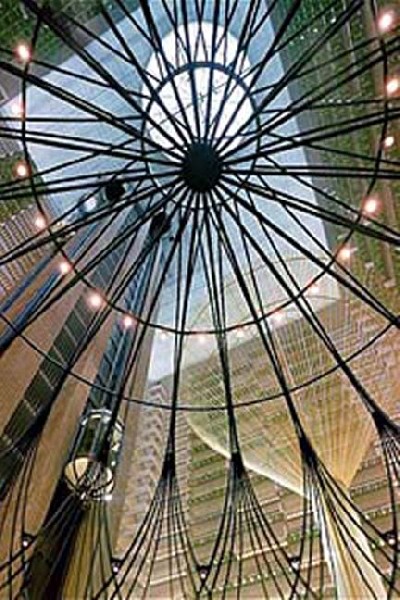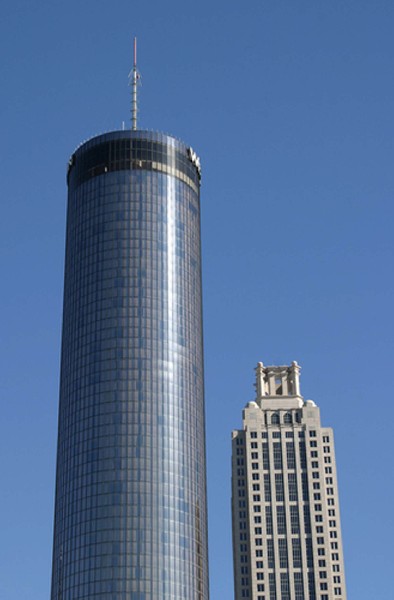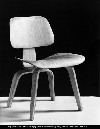Eames Film Opens MFA's Architectural Series
Architecture & Design Is Focus of Four Documentaries
By: Mark Favermann - Dec 10, 2011
Over the next couple of weeks, the Boston Museum of Fine Arts Film Department is featuring four documentaries on architecture and design. Beginning with a documentary about the designer couple Charles and Ray Eames, the series looks at films on starchitect Lord Norman Foster, developer-architerJohn portman and the on again off again on again Cuban National Art Schools project.
The Eames film Eames: The Architect and Painter by Jason Cohn (2011, 82 min.) tells the story of the husband andwife team of Charles and Ray Eames. They are widely regarded as among America’s most important designers. Their innovations are still informing contemporary design today. He was the architect, though he never finished college or got licensed, and she was an abstract painter who saw everything as a potential painting.
Their love affair began when he was already married and lasted throughout his affairs and his ego. No one on their design team but her got any credit for their projects. The Eames Office created a wide variety of products, from leg splints for wounded military during World War II, to photography,furniture, multi-media exhibits, graphics, games, films, and even toys.
Eames: The Architect and the Painter is the first film dedicated to these creative geniuses, their lives and their work. they were not friendly to outsiders, and he in particular was a loner. However, their work embraced millions. Perhaps, the biggest product that they produced was his public image. The film is enlightening and at times moving.
Eames: The Architect and Painter
Sun, Dec 11, 1 pm (Remis Auditorium)
Wed, Dec 14, 3 pm (RA)
Most followers of the New England art scene are aware that after a dozen years, Foster + Partners designed the new Art of the America wing of the boston Museum of Fine Arts. However, few no much about the starchitect Norman, no Lord Norman Foster.He was born in Manchester in 1935. After graduating from Manchester University School of Architecture and City Planning in 1961. later, he received a Master’s Degree in Architecture from Yale.
The founder and chairman of Foster + Partners in London in 1967. It is one of largest design firms in the world with project offices in more than twenty countries. Over the past four decades the company has been responsible for a strikingly wide range of work, from urban masterplans, public infrastructure, airports, civic and cultural buildings, offices and workplaces to private houses and product design.
Foster became the 21st Pritzker Architecture Prize Laureate in 1999. He has been awarded the American Institute of Architects Gold Medal for Architecture (1994), the Royal Gold Medal for Architecture (1983), and the Gold Medal of the French Academy of Architecture (1991). In 1990 he was granted a Knighthood by Queen Elizabeth II, and in 1999 was honoured with a Life Peerage, becoming Lord Foster of Thames Bank.
How Much Does Your Building Weigh, Mr. Foster? by Norberto López Amado and Carlos Carcas (2011, 80 min.). Foster + Partners’ buildings are recognizable worldwide—the Beijing Airport, the Hearst Tower in New York City, the HSBC building in Hong Kong, the Gherkin in London—and, of course, Foster is behind the Art of the Americas Wing at the MFA. A “hugely enjoyable” (The Observer) portrait of one of the world’s premier architects, the film follows his unending quest to improve the quality of life through design.
How Much Does Your Building Weigh, Mr. Foster?
Wed, Dec 14, 5 pm (RA)
Thu, Dec 15, 7:30 pm (AA)
Fri, Dec 16, 5:30 pm (AA)
Sat, Dec 17, 11 am (RA)
Sun, Dec 18, 1 pm (RA)
John Portman (b. 1924) is a prominent 20th Century architect who controversially established his early reputation in Atlanta by combining the role of architect with that of developer. Because of this financial role in his projects, Portman enjoyed a degree of independence in fulfulling his architectural visions.
He grew up in Atlanta and served in the U.S. Navy during WW II (1941-45) before graduating in 1950 from theGeorgia Institute of Technology. In 1953, Portman opened an architectural firm in Atlanta, John Portman and Associates. The firm is part of the Portman Family of Companies, which also includes Portman Holdings, a real-estate development company, and AmericasMart, a home decor wholesaler.
Portman designed numerous buildings in Atlanta, including office complexes and hotels, that were intended to revitalize the city's downtown area. His Peachtree Center Office Building (1965) in Atlanta established a model for multipurpose complexes globally, and his famous Hyatt Regency Hotel (1967) set standards for atrium and inner courtyards.
John Portman: A Life of Building by Ben Loeterman (2011, 56 min). “I need to make buildings that enhance life,” John Portman says in the beginning of this new documentary. Boston filmmaker Ben Loeterman creates a passionate portrait of Portman, recognized as one of the most innovative and imitated architects ever. Over 45 years, Portman’s iconic urban statements and eye-popping interiors have risen in 60 cities on four continents to redefine cityscapes in America, and skylines in China and the rest of Asia. The film captures Portman’s approach in an intimate portrait that, by turn, assesses and appreciates Portman’s work. Discussion with director follows the December 14 screening.
John Portman: A Life of Building
Wed, Dec 14, 7 pm (RA)
Thu, Dec 15, 6 pm (AA)
Fri, Dec 16, 4 pm (AA)
Sat, Dec 17, 1 pm (RA)
Sun, Dec 18,11:30 am (RA)
The Cuban National Schools of the Arts were to reflect the utopian optimism and revolutionary exuberance of the early years of the Cuban Revolution. Over their years of active use, the schools served as the primary incubator for Cuba’s artists, musicians, actors, and dancers.
By 1965, however, the art schools and their architects fell out of favor as uninspired Soviet functionalism became standard in Cuba. Additionally, the schools were subjected to accusations that their design was incompatible with the Cuban Revolution. These things resulted in the schools’ near complete decommissioning and the departure of two of their three architects. Never fully completed, the complex of buildings have been in various stages of use and abandonment until an attempt at completion efforts began in the first decade of the 21st century.
Unfinished Spaces by Benjamin Murray & Aylsa Nahmias (2011, 86 min.). Commissioned by Fidel Castro and Che Guevara, three young, visionary architects began construction of their radical designs for Cuba’s ambitious National Art Schools project. Classes soon followed, but as the dream of the Revolution quickly became a reality, construction halted and the architects’ designs deemed irrelevant in the prevailing political climate. Forty years later the schools are in use but remain unfinished, and Castro invites the exiled architects back to finish their unrealized dream.
Unfinished Spaces
Thu, Dec 15, 4 pm (AA)
Fri, Dec 16, 7:30 pm (AA)
Sat, Dec 17, 2:30 pm (RA)
Wed, Dec 21, 3:30 pm (RA)
Wed, Dec 22, 3:30 pm (RA)













